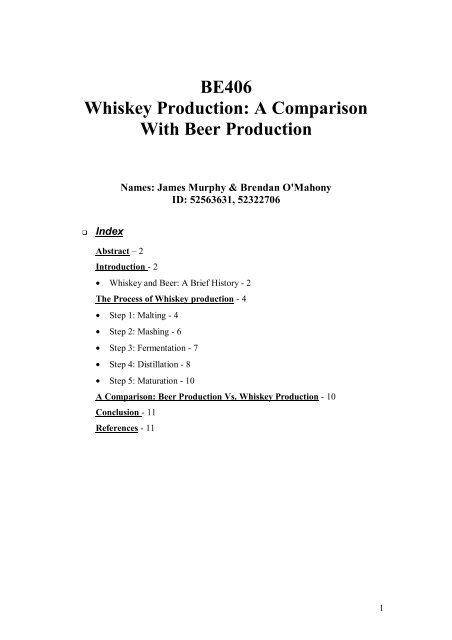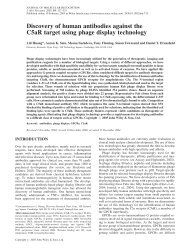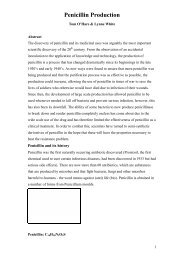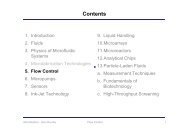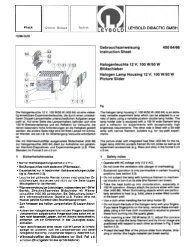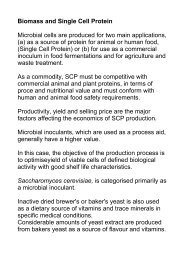BE406 Whiskey Production: A Comparison With Beer Production
BE406 Whiskey Production: A Comparison With Beer Production
BE406 Whiskey Production: A Comparison With Beer Production
Create successful ePaper yourself
Turn your PDF publications into a flip-book with our unique Google optimized e-Paper software.
<strong>BE406</strong><br />
<strong>Whiskey</strong> <strong>Production</strong>: A <strong>Comparison</strong><br />
<strong>With</strong> <strong>Beer</strong> <strong>Production</strong><br />
� Index<br />
Names: James Murphy & Brendan O'Mahony<br />
ID: 52563631, 52322706<br />
Abstract – 2<br />
Introduction - 2<br />
• <strong>Whiskey</strong> and <strong>Beer</strong>: A Brief History - 2<br />
The Process of <strong>Whiskey</strong> production - 4<br />
• Step 1: Malting - 4<br />
• Step 2: Mashing - 6<br />
• Step 3: Fermentation - 7<br />
• Step 4: Distillation - 8<br />
• Step 5: Maturation - 10<br />
A <strong>Comparison</strong>: <strong>Beer</strong> <strong>Production</strong> Vs. <strong>Whiskey</strong> <strong>Production</strong> - 10<br />
Conclusion - 11<br />
References - 11<br />
1
� Abstract<br />
In this essay, the aim is to describe in detail the processes involved in the<br />
production of whiskey, and then to compare this process with that of beer, and to see<br />
what, if any differences lie within each. The origins of <strong>Whiskey</strong> and <strong>Beer</strong> are quite<br />
old, but the principles behind the production technique are still the same today, albeit<br />
the technology has changed to ensure improvements in quality etc. The six steps in<br />
the production of whiskey are Malting, Mashing, Fermentation, Distillation and<br />
Maturation, and these will be covered in great detail. The comparison between the<br />
two alcoholic beverages will focus solely on the production process changes, and does<br />
not embody and difference between the characteristics of each particular drink. It is<br />
from this comparison that it is hoped that the differences, if any in production process,<br />
will be clearly illustrated.<br />
� Introduction<br />
<strong>Whiskey</strong> is a barrel-aged alcohol made from grains or malts. It acquires its<br />
colour and flavour from the wooden barrels over time, and in this way whiskey differs<br />
from other grain alcohols. Through the distilling process, it keeps most of its flavour<br />
from the fermented mash by being distilled at a lower proof, and in this way has a<br />
stronger flavour than vodka. It has no other ingredients added to it, unlike other spirits<br />
like gin, etc.<br />
<strong>Beer</strong> has many definitions, amongst them are:<br />
i. A fermented alcoholic beverage brewed from malt and flavoured with hops.<br />
ii. A fermented beverage brewed by traditional methods that is then<br />
dealcoholised so that the finished product contains no more than 0.5 percent<br />
alcohol.<br />
iii. A carbonated beverage produced by a method in which the fermentation<br />
process is either circumvented or altered, resulting in a finished product<br />
having an alcohol content of no more than 0.01 percent.<br />
iv. A beverage made from extracts of roots and plants: birch beer.<br />
v. A serving of one of these beverages.<br />
• <strong>Whiskey</strong> and <strong>Beer</strong>: A Brief History<br />
The origin of whiskey is somewhat unclear, but the general consensus is this:<br />
In 6 th century AD, Irish missionary monks journeyed to the Middle East where it is<br />
2
thought they observed the Arabs using the alembic * to distil perfume. Modern<br />
distillation process can be traced back to the Arabs, however it is the distillation, and<br />
production of <strong>Whiskey</strong> that is accredited to the Irish people. The monks brought back<br />
the new method of distillation back to Ireland, where they then developed their own<br />
version, the “Pot Still”. The knowledge quickly spread throughout the church, and<br />
over the monastery walls.<br />
<strong>Beer</strong> on the other hand is quite an ancient tradition, with archaeological<br />
records dating back to the time of the Sumerians in Mesopotamia, about 6000 years<br />
old, where a tablet depicts people drinking a beverage through reeds and becoming,<br />
“blissful, relaxed and exhilarated”. Another mention of beer from ancient times is in<br />
the “Epic of Gilgamesh” a 3900-year-old poem in honour of the goddess of brewing,<br />
“Ninkasi”. <strong>Beer</strong> developed independently throughout most of the world, with different<br />
cultures having there own take on beer, for instance the pre-Columbian civilisations in<br />
the America’s used corn instead of barley. <strong>Beer</strong> was quite popular with the Romans<br />
and Greeks, until wine became freely available in the empire. <strong>Beer</strong> was deemed a<br />
barbarians drink, and few places in the empire brewed it. In the middle ages,<br />
European monks were the guardians of literature and science, as well as the art of beer<br />
making. Both whiskey and beer production today are hugely profitable products, and<br />
are controlled by multinational conglomerates such as Diageo.<br />
The actual development of production of Irish whiskey has not changed<br />
enormously. <strong>Production</strong> still follows the same principle steps as initial distillation<br />
practices, albeit the technology has changed, and has become more refined. These<br />
changes were introduced also to brewing, and so a common bond is shared between<br />
them historically. One particular difference between whiskey and beer is the addition<br />
of hops to beer. This took place only recently (with respect to beer’s history), around<br />
the 15 th century.<br />
� Industrialisation of beer really took off with the invention of the steam engine<br />
in 1765.<br />
� Prior to the late 18 th century, malt was primarily wood-roasted, which gave it a<br />
dark colour and smoked flavour, but with the increasing availability of coal,<br />
when used in production processes, it lightened the colour and eliminated the<br />
smoke flavour.<br />
* An Alembic is an alchemical still consisting of two retorts connected by a tube. Technically, the<br />
alembic is only the upper part (the capital or still-head), but the word was often used to refer to the<br />
entire distillation apparatus.<br />
3
� The invention of the thermometer and hydrometer in the 19 th century,<br />
improved quality control, with regards to increasing efficiency and<br />
attenuation.<br />
� In 1817, Daniel Wheeler invented the drum roaster allowed for the creation of<br />
very dark, roasted malts, contributing to the flavour of porters and stouts.<br />
� In 1857 Louis Pasteur discovered the role of yeast in fermentation. This gave<br />
more control in preventing the souring of beer by undesirable microorganisms.<br />
� In the1950s, Morton Coutts developed the technique of continuous<br />
fermentation. This process revolutionised the industry. During the continuous<br />
brewing process materials are added to one end of the system and<br />
continuously withdrawn from the other end. The standard system for brewing<br />
beer had ingredients put in together and then after a period of time (15 weeks)<br />
the brewed beer is removed and bottled altogether at the same time. This<br />
process is still used by many of the world's major breweries today, including<br />
Guinness.<br />
� The Process of <strong>Whiskey</strong> <strong>Production</strong><br />
The production of whiskey as a process is actually is quite simple. The most<br />
important part in making whiskey is the three main ingredients; Malted barley, water,<br />
and yeast. These ingredients undergo a process, which consists of five major steps, to<br />
produce whiskey. The steps are as follows; Step 1: Malting, Step 2: Mashing, Step<br />
3: Fermentation, Step 4: Distillation, and Step 5: Maturation. We will now look at<br />
each step individually to show practices involved in modern whiskey production.<br />
• Step 1: Malting<br />
Malting is the first step in whiskey production and it is a step that is made up<br />
of many smaller steps. It usually takes up to 5 - 7 days. The object of malting is to<br />
develop Enzymes from the barley and modify the starch present in the grain into<br />
fermentable sugars. First off the barley is collected from the fields, dried and stored.<br />
The drying and storage of barley is an important process in itself, as the moisture<br />
content must be lowered to prevent the germination of the seeds. This is very<br />
important in the likes of Ireland as the field barley tends be typically high in moisture.<br />
The barley, on intake, is dried for 2~3 hours at an air temperature no higher than<br />
52°C. The barley can then be stored at 25°C for 1-2weeks in an airtight silo or<br />
concrete bunker. For long term storage the temperature must be lowered to about<br />
4
Embryo<br />
15°C and respiration in the barley grains maintained by keeping silos aerobic. Simply<br />
moving the grain from silo to silo can do this.<br />
The next step involves the steeping of the barley grain in water. In steeping the<br />
coat or husk of the grain is penetrated by the water, which increases the moisture<br />
content of the grain in turn increasing the grains metabolism and subsequent<br />
respiration. When these factors are increased the aeration of the grain must also be<br />
increased to insure that the metabolism does not become anaerobic. If this where to<br />
happen toxicity in the grain would increase in the form of CO2 and Ethanol. During<br />
steeping the early stages of embryonic growth are initiated, and this growth is<br />
continued through germination. It should be noted that regular aeration of the grain is<br />
carried out during the steeping process.<br />
A grain of barley consists of two main parts, the Embryo and the Endosperm.<br />
The embryo is the most important part of the grain as it houses all the organs that<br />
would develop into plant. The embryo is made up of three parts, the cotyledon (seed<br />
leaf), the epicotyl (shoot), and the radicle (root). The barley seed is a monocot due to<br />
it having only one cotyledon. The Endosperm contains the food source for the<br />
embryo, starch, protein, and its cell wall. The endosperm is utilised by the Embryo in<br />
the early stages of germination. The starch is converted, hydrolytically, to fermentable<br />
or simple sugars by enzymes that are secreted by the barley during germination.<br />
Below is a diagram of what a grain of barley looks like, and the subsequent reactions<br />
undergone during germination.<br />
Two forms of starch exist in the grain, amylase and amylopectin. The<br />
following enzymes degrade to starch into smaller polysaccharides; α-amalyse, β-<br />
amalyse, α-glucosidase, and phosphorylase. The most important of the enzymes<br />
5
would be α-amalyse and β-amalyse. α-amalyse is synthesised once germination<br />
begins while β-amalyse is present in the grain in an inactive form, which subsequently<br />
becomes active during germination. α-amalyse is involved in the modification of the<br />
starch, attacking it randomly and cleaving it into short polysaccharides known as<br />
dextrins. β-amalyse attacks non-reducing ends of the starch producing maltose.<br />
Germination is usually carried out in drum or Box maltings. In Box malting<br />
the air temperature, which is saturated with moisture, is controlled and passed through<br />
the grain via holes in the box floor to maintain aeration of the grain. Turners are also<br />
employed to keep the grain free and to assist in the equal passage of air throughout the<br />
bed from the floor. This system provides ideal conditions for the germination of the<br />
barley irrespective of the atmospheric conditions.<br />
Once the barley grain begins sprouting, it is termed “green malt”, and is ready<br />
for drying. The “green malt” as it is termed on the completion of germination<br />
transferred to a malt kiln, which is a large drum with a furnace at the base, for drying.<br />
Hot air, from a hot air chamber located above the furnace and beneath the kiln, moves<br />
up through the grain, usually assisted by a fan. This heat is distributed evenly through<br />
out the grain. This drying step stops germination (denatures the enzyme β-amalyse)<br />
and changes the malt to a condition suitable for milling. Depending on whether the<br />
kiln is an open or closed kiln and what fuel is used in the furnace a flavour can be<br />
imparted to the malt. E.g. peat is usually burned for a scotch whiskey, while the likes<br />
of Jameson use a closed kiln allowing no smoke to come in contact with the drying<br />
malt, ensuring that the taste of the malt and barley are present in the final product.<br />
• Step 2: Mashing<br />
The grounded malted barley or grist is then added to a mash tun along with a<br />
precise amount of hot water. The mash tun is a circular metal vessel, which has<br />
mechanical stirrers that revolve and rotate to ensure thorough mixing of the grist and<br />
hot Water. The objective in mashing the malt is to dissolve as much of the valuable<br />
malt as possible. Enzymatic actions are undergone in the mashing process to convert<br />
starch to sugar. This enzyme action is influenced to a large extent by the<br />
concentration of the mash, its pH, and the water temperature. The resulting product is<br />
a sugary liquid known as the wort. The wort will contain intermediate products as<br />
well sugars.<br />
The wort is then collected in a wort receiver, which is located beneath the<br />
perforated floor of the mash tun. This allows the wort to drain and the grain to be<br />
6
etained in the tun. This process usually involves application of more water to ensure<br />
that no wort is left with the grain.<br />
The water used tends to play an important part in the final product. As water’s<br />
quantity in regards to type’s of minerals and organisms varies from region to region<br />
the location of production is as important as the barley grain used as to ship water<br />
would be costly and involve a lot of time and labour. Jameson whiskey is produced in<br />
Midleton cork (also the home of Irish Distillers Ltd) due to the waters being generally<br />
soft, as hard water would be unsuitable for the process. Regular analysis of water<br />
sources such as springs and burns assists in the prevention of contamination.<br />
It should be noted that there is also a technique employed by American<br />
distillery’s known as “double mashing” that uses low levels of cereal adjuncts, such as<br />
rice or maze, that are high in starch. These cheaper sources of extract are employed<br />
due to their ability to exploit high enzyme activity. This process also dilutes any<br />
unwanted nitrogenous compounds. Another technique used in the making of bourbon<br />
and Tennessee whiskeys is “sour mash”. This involves the use of a portion of a<br />
previous mashing batch to start the next batch. Its quite similar to what is mentioned<br />
above with reference to the final wash, except this portion tends to come from the<br />
final mash product. The ides of this practice is to maintain consistency. The reason for<br />
the name is because the practice is quite similar to the making of sourdough bread.<br />
• Step 3: Fermentation<br />
Fermentation is the conversion of sugars, contained in the wort, to alcohol.<br />
This is done under the action of yeast, producing alcohol and carbon dioxide<br />
[C6H12O6 —> 2 (C2H5OH) + 2 (CO2)] with an emission of heat. Yeast, upon<br />
introduction to the wort, can convert fermentable sugars in three ways i) aerobically<br />
through respiration, but only if there is a high abundance of oxygen available through<br />
out the process, ii) growth or multiplication, by utilising the sugars to form new cell<br />
materials, or by iii) fermentation. Fermentation is an anaerobic reaction.<br />
During fermentation yeast can be seen to act in three stages. The first stage is<br />
the lag stage where not much fermentation is observed, due the yeast generally<br />
adapting to its new environment. Precautions need to be taken during the addition of<br />
the yeast to the wort as were bacterial contamination to occur it would cause a great<br />
deal of damage to the batch leading to poor fermentation, poor yield of spirit, and<br />
poor quality/taste in the final product. To prevent such an event strict cleaning and<br />
sterilisation is performed to ensure that the mashing and fermenting process remain<br />
bacteria free at all times.<br />
7
The second stage is the stage of rapid fermentation or the log phase. During<br />
the log phase the fermentation rate is at it’s highest. Temperatures sore during this log<br />
phase and should be monitored with great care. If the temperature increases to rapidly<br />
or exceeds 35°C the yeast will be denatured and a high percentage of spirits lost. In<br />
this phase rotating metal blades, known as switchers, are usually used to quell the<br />
froth caused to the production CO2.<br />
The final stage is the slowing and termination of the fermentation reaction, which<br />
tends to be down to there being no fermentable sugars left in the wort. Generally<br />
fermenting never lasts more than 48 hours and any fermentation that may occur past<br />
the mark is considered to be insignificant. This being said the rate of fermentation is<br />
variable and down to such factors as temperature, type and amount of yeast used, its<br />
condition, type of malt, purity of water and amount of suspended solids in the wort.<br />
The product yielded after distillation of the wort is a weak beer substance known as<br />
the wash.<br />
• Step 4: Distillation<br />
Distilling of the wash (product from fermentation) involves vaporisation and<br />
condensation. This simple means heating the liquid to vapour then cooling it back to<br />
liquid. Distillation is a means of separating the alcohol and the solids/liquid/residue in<br />
the wash. The reason this separation is needed is because the wash is made up of dead<br />
yeast etc from the fermentation process. It is necessary that solids/residues from the<br />
fermentation process remain suspended during the distillation process so that they do<br />
not stick to the sides and burn the still. To prevent this three rotating arms attached to<br />
brass and copper chains are used, inside the still, to keep the wash agitated and<br />
constantly moving. This device is known as a rummager.<br />
The still is two large copper pots of different sizes that are bridged (connected)<br />
at the top by what is known as a swan neck. Below is a picture of a simple two copper<br />
pot still.<br />
Spirit still<br />
Swan neck<br />
Still containing<br />
wash<br />
8
The wash is placed in one of the copper pots, usually the large of the two and<br />
is heated to high enough temperatures that promote the formation of alcohol vapour.<br />
This varies from whiskey to whiskey as it relies upon the percentages of alcohol, litres<br />
of wash, and measured distillate collection of the still. A more accurate way of<br />
measuring cut off point is % of alcohol rather than temperature. Anyways, the alcohol<br />
vapour will rise to the swan neck and subsequent condenser, which is a series of pipes<br />
wrapped in a cooling (cold-water) jacket. It is here, in the condenser, that the alcohol<br />
vapour will condense into liquid and be collected in the smaller of the two copper<br />
pots. This pot is known as the spirit still. The newly condensed alcohol tends to be of<br />
about ~20% and termed low wines. This percentage will differ from distillery to<br />
distillery depending on materials, methods, and desired product but his is the general<br />
figure expected. This alcohol strength is measured in the spirit safe. Prior to the<br />
alcohol flowing into the spirit still it passes through the spirit safe, which is a control<br />
point of distillation. It is here in the spirit safe that the alcohol may be tested for<br />
strength by an internal hydrometer located in the safe.<br />
The height of the wash’s froth is monitored during distillation as high<br />
temperatures may cause the froth to reach excessive heights and spill into the spirit<br />
still via the bridging swan neck. A small window in the first pot monitors this, and<br />
adjustments to temperature are made accordingly.<br />
The majority of whiskeys undergo a second distillation of the first distillation<br />
product. The original Irish distillation process dictates that a triple distillation be<br />
performed in the making of whiskey. This is employed by most if not all whiskey<br />
produced in Ireland, such as Jameson’s distillery, Midleton, Co. Cork. “The<br />
distillation of Jameson follows the traditional method employed for whiskey<br />
distillation in Ireland. Distillation is carried out using traditional techniques in Pot<br />
Stills. The Irish tradition requires three distillation stages… Grain <strong>Whiskey</strong>, is also<br />
distilled through three columns. Unlike the practice elsewhere, the columns include<br />
a <strong>Beer</strong> Column, Extractive column, and Rectifying column… By products from the<br />
plant are dried and sold as distillers dried grains. All residual process liquid streams<br />
are finally processed through an on site effluent plant.” – Barry Crockett of<br />
Jameson Distillery, Midleton, Co. Cork.<br />
Jameson believes each distillation lends to the final whiskey products<br />
smoothness and superior quality. Once triple distillation is completed the product is<br />
termed “new whiskey” and is ready for the maturation stage.<br />
9
• Step 5: Maturation<br />
Oak casks tend to be the standard used for maturation of new whiskey, as well<br />
as blending of different whiskeys from different distillation batches and matured<br />
whiskeys, and the process of maturation can take anything from 3 to 15 years<br />
depending on the quality desired. The reason for oak casks being used opposed to<br />
other wooden casks is oaks ability to absorb impurities and its ability to allow the<br />
whiskey to breath. An interesting part of the maturation process is the loss of alcohol<br />
through evaporation. This is generally termed the “angels share”, and it is usually<br />
about 10 to 8 percent of the alcohol in the first year, with a loss of 4% every year<br />
after. A good whiskey is estimated to lose approximately 30% of its original volume<br />
before being bottled. The process of maturation tends to change from distillery to<br />
distillery depending on what flavour, quality, and final taste is desired. Traditions of<br />
production also tend to dictate maturation process used for the whiskey.<br />
The maturation of Jameson whiskey is done in oak casks that have been<br />
previously seasoned by holding bourbon and sherry. This is done to make the final<br />
taste of the whiskey more distinct with a smooth after taste. Jameson also employs<br />
blending of different batches of whiskey to acquire good flavour in taste.<br />
� A <strong>Comparison</strong>: <strong>Beer</strong> <strong>Production</strong> vs. <strong>Whiskey</strong> <strong>Production</strong><br />
<strong>Beer</strong> production and whiskey production are very similar in the fact that they<br />
both require malted barley. The initial ingredients for production of both drinks are<br />
the same, although inferior American beers choose to substitute barley with rice, corn,<br />
or other cheap starch rich grains. Brewery malt is usually manipulated in various ways<br />
(e.g. roasting) to create different flavours and colours, creating a range that stretches<br />
from Pilsner or light beers to dark lagers and stouts such as Guinness. For beers, hops<br />
are added to the wort prior to fermentation to add taste. It is this addition of hops that<br />
makes beer what it is and gives it its flavour. Once the hop flavour has taken to the<br />
wort it is then cooled the hops extracted prior to fermentation.<br />
The production process of fermentation for both beer and whiskey undergo the<br />
same reactions except that the fermentation of beer tends to go for a much longer<br />
period of time, 7-10days, and at a much lower temperature of 7-25°C depending on<br />
the type of beer being brewed, opposed to whiskey fermentation, which is run at a<br />
temperatures as high as 25-30°C and lasts for only 48 hours yielding a weak hopless<br />
beer that is known as wash. However continuous fermentation can be used to speed<br />
up the fermentation of beer to times as quick as 24 – 30 hours. Fermentation is the last<br />
10
step of brewing; it is then blended and matured for anything from 1 to 4 weeks in oak<br />
casks.<br />
The yeast used during the fermentation of beer tends to be recycled and used<br />
in the brewing of other batches of beer. In some cases the yeast is not full extracted<br />
from the final beer resulting in what is known as a “vice-beer”. Vice beer tend to be<br />
very white in colour and sometimes cloudy, and example of a vice beer would be<br />
Stella Artois <strong>Beer</strong> from Belgium. Neither of these methods are practiced in the<br />
production of whiskey.<br />
Due to production processes and final maturation processes being quite<br />
similar, in the use of oak casks, similar flavours can be observed in good whiskeys<br />
and good beers, independent of actual alcohol levels.<br />
� Conclusion<br />
From the above, it can be seen that both <strong>Whiskey</strong> and <strong>Beer</strong> are very similar in<br />
the production processes, though distillation and maturation really separates the two<br />
products. While both have similar production backgrounds, their histories are quite<br />
different, whiskey being a homegrown effort for the Irish. Although not really<br />
touched upon in this essay, both drinks are quite different, and the different varieties<br />
ensure a multitude of ways to make a mess of yourself, especially when mixed. The<br />
best and worst whiskies come down to a matter of taste, though Midleton was one of<br />
the more highly regarded whiskies available. As for beer, the numerous brands, and<br />
styles make it impossible for one to recommend any brand in particular.<br />
� References<br />
The dictionary of beer and brewing, 2 nd edition, by Dab Rabin and Carl Forget<br />
1000 years of Irish whiskey, by Malachy Magee<br />
Malting and brewing science, 2 nd edition, by D.E. Briggs<br />
http://www.ces.purdue.edu/extmedia/AE/AE-117.html<br />
www.mindspring.com/~mccarthys/whiskey/corn.htm<br />
http://www.whisky.com/index.html<br />
http://www.le-brewery.com/productionofbeer.htm<br />
http://www.beerinfo.com/vlib/<br />
http://www.tourismvictoria.com/Content/EN/349.asp<br />
http://en.wikipedia.org/wiki/<strong>Beer</strong><br />
Barry Crockett of Jameson Distillery, Midleton. Co. Cork, and The Old Jameson<br />
Distillery, Smithfield village. Co. Dublin.<br />
11


